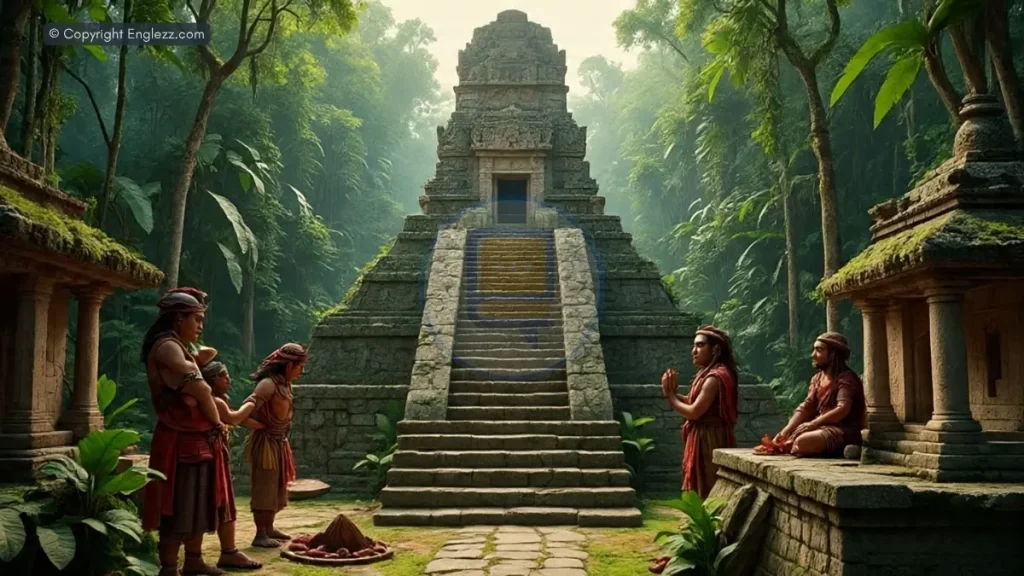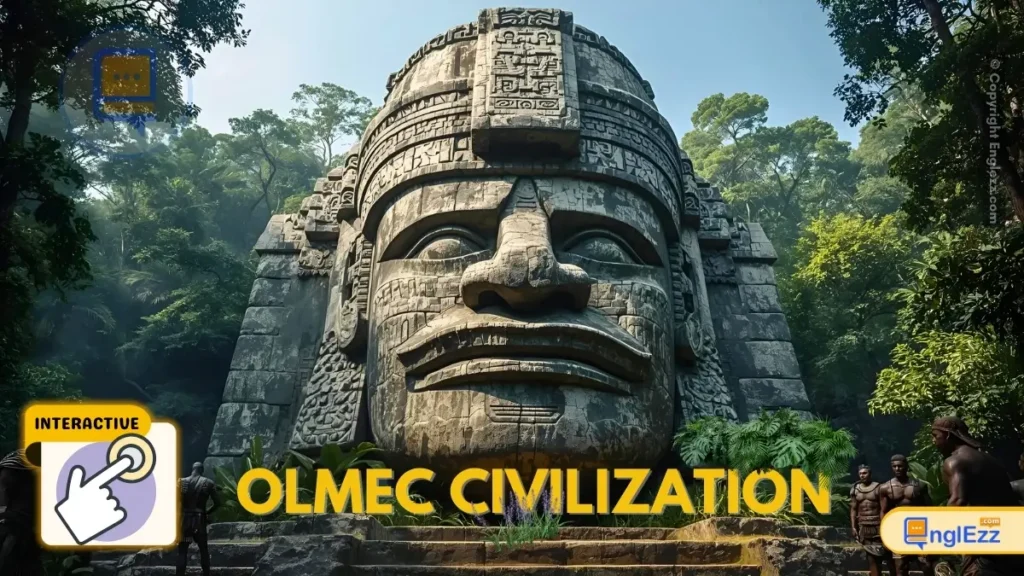
The Olmec Civilization
Mesoamerica’s “Mother Culture” (1500-400 BCE)
Introduction
The First Great Civilization of Mesoamerica
The Olmec civilization (1500-400 BCE) was the first major civilization in Mesoamerica and is often considered the “mother culture” of later civilizations like the Maya and Aztec. Flourishing in the tropical lowlands of south-central Mexico (modern-day Veracruz and Tabasco), the Olmec established many cultural patterns that would spread throughout the region.
The Olmec are best known for their colossal stone heads, sophisticated art style, and early developments in writing, astronomy, and mathematics. They built the first large-scale ceremonial centers in Mesoamerica and established extensive trade networks that connected distant regions. The Olmec also developed the Mesoamerican ballgame and created the first writing system in the Americas.
Early Olmec Period
The Early Olmec period (1500-900 BCE) saw the rise of the first Olmec centers like San Lorenzo, which became the most important site of this era. During this time, the Olmec developed their distinctive artistic style, built monumental architecture, and established trade networks that extended hundreds of miles.
Middle Olmec Period
The Middle Olmec period (900-400 BCE) marked the peak of Olmec civilization, with La Venta becoming the dominant center. This period saw the creation of the famous colossal heads, advances in writing and calendrics, and the spread of Olmec cultural influence throughout Mesoamerica.
Late Olmec Period
The Late Olmec period (400-100 BCE) saw the decline of major Olmec centers, though their cultural influence continued to spread. During this time, Olmec artistic styles and concepts were adopted and adapted by emerging civilizations throughout Mesoamerica, ensuring the Olmec legacy would endure.
Interactive Olmec Civilization Timeline
Emergence of Olmec Culture
The first signs of Olmec culture appear in the Gulf Coast region, with early settlements showing distinctive Olmec artistic styles.
Read moreAround 1500 BCE, the first distinctive Olmec cultural traits emerged in the Gulf Coast region of Mexico, particularly in the area now known as the states of Veracruz and Tabasco. This region, with its abundant water resources and fertile soil, provided an ideal environment for the development of complex society.
Early Olmec sites show evidence of:
- Specialized pottery production
- Early monumental architecture
- Distinctive artistic motifs featuring jaguars and other supernatural beings
- Evidence of long-distance trade networks
During this formative period, the Olmec began developing the cultural patterns that would characterize their civilization and influence later Mesoamerican cultures.
Further Reading
- Diehl, Richard A. The Olmecs: America’s First Civilization (2004)
- Pool, Christopher A. Olmec Archaeology and Early Mesoamerica (2007)
San Lorenzo Flourishes
San Lorenzo becomes the dominant Olmec center, featuring monumental architecture and sophisticated drainage systems.
Read moreBy 1200 BCE, San Lorenzo had emerged as the most important Olmec center, dominating the Coatzacoalcos River basin. The site covered about 1,400 acres at its peak and featured:
- Massive earthen platforms and mounds
- Sophisticated drainage systems using basalt troughs
- Monumental stone sculptures, including early colossal heads
- Evidence of elite residences and specialized craft production
San Lorenzo’s rulers controlled extensive trade networks that brought in exotic materials like jade and obsidian from distant regions. The site’s monumental art and architecture demonstrate the growing power of Olmec rulers and the increasing complexity of their society.
San Lorenzo began to decline around 900 BCE, possibly due to environmental changes or political upheaval, with La Venta emerging as the new dominant center.
Further Reading
- Cyphers, Ann. San Lorenzo, Veracruz: The First Olmec Capital (2012)
- Symonds, Stacey, et al. Settlement History in the San Lorenzo Region (2002)
Rise of La Venta
La Venta becomes the premier Olmec center, featuring the Great Pyramid and numerous monumental sculptures.
Read moreAround 900 BCE, La Venta emerged as the new dominant Olmec center, located on an island in the Tonalá River. The site represents the height of Olmec architectural and artistic achievement, featuring:
- The Great Pyramid, an enormous clay mound 110 feet high
- Complex ceremonial precincts with mosaic pavements
- Numerous colossal heads and other monumental sculptures
- Elaborate tombs with rich offerings
La Venta’s rulers demonstrated their power through monumental construction projects and control of valuable trade goods. The site’s alignment and organization suggest sophisticated astronomical knowledge and cosmological concepts that would influence later Mesoamerican cultures.
La Venta remained the most important Olmec center until the civilization’s decline around 400 BCE.
Further Reading
- González Lauck, Rebecca. La Venta: An Olmec Capital (2010)
- Reilly, F. Kent. Art, Ritual, and Rulership in the Olmec World (1999)
Creation of Colossal Heads
Olmec sculptors create the famous colossal heads, believed to represent rulers or ancestors.
Read moreThe colossal heads are the most iconic Olmec artworks, with 17 known examples ranging from 5 to 11 feet tall and weighing up to 50 tons. These massive basalt sculptures were carved from stone transported from the Tuxtla Mountains, up to 80 miles away.
Key features of the colossal heads:
- Each head has unique facial features, suggesting they represent specific individuals
- They wear distinctive headgear, possibly representing ballgame helmets
- The largest examples required hundreds of workers to transport and carve
- They were often buried and repositioned, suggesting ritual significance
Most scholars believe the heads depict Olmec rulers, serving as monuments to their power and authority. The enormous effort required to create them demonstrates the rulers’ ability to command vast labor resources.
Further Reading
- de la Fuente, Beatriz. The Olmec World: From the Valley of Mexico to the Gulf Coast (1996)
- Taube, Karl A. Olmec Art at Dumbarton Oaks (2004)
Decline of Major Centers
La Venta and other major Olmec centers are abandoned, marking the end of the Olmec as a dominant civilization.
Read moreAround 400 BCE, the major Olmec centers like La Venta were abandoned, marking the end of Olmec political dominance. The reasons for this decline are not fully understood but may include:
- Environmental changes affecting agriculture
- Political upheaval or internal conflict
- Shifts in trade networks
- The rise of competing centers in other regions
While the Olmec ceased to exist as a distinct civilization, their cultural influence continued to spread throughout Mesoamerica. Many Olmec artistic motifs, religious concepts, and cultural practices were adopted and adapted by later civilizations like the Maya and Zapotec.
Smaller Olmec-related sites persisted for several more centuries, and Olmec artistic styles continued to influence regional cultures, demonstrating the enduring legacy of this “mother culture.”
Further Reading
- Blomster, Jeffrey P. After Olmec: The Legacy of Mesoamerica’s First Civilization (2012)
- Stark, Barbara L., and Philip J. Arnold III. Olmec to Aztec: Settlement Patterns in the Ancient Gulf Lowlands (1997)
Discovery of Colossal Head
The first Olmec colossal head is discovered at Tres Zapotes, introducing the Olmec to modern archaeology.
Read moreIn 1862, Mexican explorer José María Melgar y Serrano discovered the first Olmec colossal head at Tres Zapotes. This accidental discovery marked the beginning of modern awareness of the Olmec civilization, though their significance wasn’t fully understood until much later.
Key developments in Olmec archaeology:
- Early 20th century: Archaeologists begin recognizing Olmec artifacts as distinct from Maya works
- 1930s-1940s: Matthew Stirling conducts major excavations at La Venta and other sites
- 1942: The term “Olmec” is formally adopted to describe this culture
- 1960s-present: Ongoing research reveals the Olmec as Mesoamerica’s first complex civilization
Today, the Olmec are recognized as the “mother culture” of Mesoamerica, having established many cultural patterns that would be adopted by later civilizations in the region.
Further Reading
- Benson, Elizabeth P. The Olmec and Their Neighbors (1981)
- Stirling, Matthew W. Discovering the Olmecs: An Unconventional History (1968)
Cascajal Block Discovery
Archaeologists discover the Cascajal Block, containing the oldest known writing in the Americas.
Read moreIn 2002, archaeologists announced the discovery of the Cascajal Block at a site near San Lorenzo. This serpentine slab, dating to about 900 BCE, bears 62 symbols that constitute the oldest known writing in the Western Hemisphere.
Significance of the Cascajal Block:
- Provides evidence that the Olmec developed the first writing system in the Americas
- Contains symbols that may represent objects, concepts, or sounds
- Demonstrates that writing in Mesoamerica began earlier than previously thought
- Suggests the Olmec may have influenced later writing systems like Maya hieroglyphs
While the Cascajal Block’s symbols haven’t been fully deciphered, its discovery confirmed that the Olmec had developed a form of writing centuries before the Maya. This finding reinforced the Olmec’s status as Mesoamerica’s foundational civilization.
Further Reading
- Rodríguez Martínez, María del Carmen, et al. Oldest Writing in the New World (2006)
- Pohl, Mary E. D., et al. Olmec Origins of Mesoamerican Writing (2002)
Olmec Civilization Quiz
Test Your Knowledge of Olmec History
Frequently Asked Questions
Common Questions About Olmec Civilization
The Olmec are called Mesoamerica’s “mother culture” because they developed many cultural patterns that were adopted and adapted by later civilizations in the region. These include:
- Artistic styles: The distinctive Olmec art style influenced later Maya, Zapotec, and Aztec art
- Religious concepts: Olmec deities and religious symbols appear in later cultures
- Political organization: The Olmec established patterns of rulership and monumental architecture
- Writing systems: The Olmec may have developed the first writing system in the Americas
- Calendar and astronomy: Early calendrical systems likely originated with the Olmec
While some scholars argue for a “sister culture” model where multiple civilizations developed independently, the Olmec’s early date and widespread influence support their status as a foundational culture.
The Olmec colossal heads are massive basalt sculptures depicting human faces, each with distinctive features. Most scholars believe they represent:
- Olmec rulers: The unique facial features suggest portraits of individual leaders
- Ancestors: They may commemorate deceased rulers or important ancestors
- Ballplayers: The headgear may represent protective helmets used in the Mesoamerican ballgame
The heads range from 5 to 11 feet tall and weigh up to 50 tons. Their creation required transporting massive basalt boulders from distant quarries, demonstrating the rulers’ ability to organize large-scale labor projects.
Seventeen colossal heads have been discovered at four Olmec sites, with the largest number (10) at San Lorenzo.
Evidence suggests the Olmec did develop a form of writing, though it’s not fully understood. Key findings include:
- Cascajal Block: Dated to about 900 BCE, this serpentine slab contains 62 symbols arranged in rows
- Other inscriptions: Short texts appear on portable objects like celts and figurines
- Possible calendar: Some symbols may relate to early calendrical systems
While the Olmec writing system hasn’t been deciphered, it likely influenced later Mesoamerican scripts like the Maya hieroglyphs. The Cascajal Block represents the oldest known writing in the Western Hemisphere.
Some scholars believe the Olmec used writing primarily for ritual or political purposes rather than for extensive record-keeping.
The Olmec civilization declined around 400 BCE, with their major centers abandoned. Possible reasons include:
- Environmental changes: Shifting river courses or climate changes may have disrupted agriculture
- Political upheaval: Internal conflicts or rebellions could have weakened the society
- Economic factors: Changes in trade networks may have reduced their influence
- External pressures: Emerging cultures may have challenged Olmec dominance
Despite their decline as a political force, Olmec cultural traditions lived on. Many elements of Olmec art, religion, and political organization were adopted by later civilizations like the Maya and Zapotec, ensuring the Olmec legacy endured for centuries.
Smaller Olmec-related communities persisted in the region for several more centuries before being fully absorbed into later cultures.
Conclusion
The Olmec Legacy
The Olmec civilization (1500-400 BCE) stands as Mesoamerica’s first great culture, establishing foundational patterns that would influence all subsequent civilizations in the region. From their heartland in the Gulf Coast lowlands, the Olmec developed sophisticated art, architecture, political systems, and possibly writing that spread throughout Mesoamerica.
While the Olmec declined as a distinct civilization by 400 BCE, their cultural legacy endured. The Maya, Zapotec, Teotihuacanos, and Aztecs all incorporated Olmec-derived elements into their own cultures, from artistic motifs to religious concepts to political symbolism.
Olmec Civilization Key Takeaways
First Complex Society
The Olmec established Mesoamerica’s first complex society with monumental architecture, organized labor, and social stratification.
Artistic Achievements
The Olmec created distinctive art styles, including colossal heads and jade figurines, that influenced later cultures.
Cultural Diffusion
Olmec ideas and styles spread throughout Mesoamerica through trade and possibly migration.
Writing and Calendrics
The Olmec likely developed Mesoamerica’s first writing system and calendrical traditions.
Religious Innovations
Olmec religious concepts, including the were-jaguar and feathered serpent, became pan-Mesoamerican motifs.
The study of Olmec civilization provides crucial insights into the origins of complex societies in Mesoamerica. As archaeologists continue to uncover new finds like the Cascajal Block, our understanding of this foundational culture grows deeper, revealing the remarkable achievements of America’s first civilization.
Recommended Reading About Olmec Civilization
- Diehl, Richard A. The Olmecs: America’s First Civilization (2004)
- Pool, Christopher A. Olmec Archaeology and Early Mesoamerica (2007)
- Blomster, Jeffrey P. After Olmec: The Legacy of Mesoamerica’s First Civilization (2012)
- de la Fuente, Beatriz. The Olmec World: From the Valley of Mexico to the Gulf Coast (1996)
- Taube, Karl A. Olmec Art at Dumbarton Oaks (2004)









